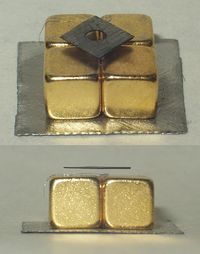.
Magnetic levitation
Magnetic levitation, maglev, or magnetic suspension is a method by which an object is suspended above another object with no support other than magnetic fields. The electromagnetic force is used to counteract the effects of the gravitational force.
Stability
Earnshaw's theorem proved conclusively that it is not possible to stably levitate using static, macroscopic, "classical" electromagnetic fields. The forces acting on an object in any combination of gravitational, electrostatic, and magnetostatic fields will make the object's position unstable. However, several possibilities exist to make levitation viable, by violating the assumptions of the theorem — for example, the use of electronic stabilization or diamagnetic materials.
Methods
There are several methods to obtain magnetic levitation. The primary ones used in maglev trains are servo-stabilized electromagnetic suspension (EMS), electrodynamic suspension (EDS), and Inductrack.
Mechanical stabilization
If two magnets are mechanically constrained along a single vertical axis (a piece of string, for example), and arranged to repel each other strongly, this will act to levitate one of the magnets above the other. This is not considered true levitation, however, because there is still a mechanical contact. A popular toy based on this principle is the Revolution by Carlisle Co., which constrains repelling magnets against a piece of glass.
Direct Diamagnetic levitation

A substance which is diamagnetic repels a magnetic field. Earnshaw's theorem does not apply to diamagnets; they behave in the opposite manner of a typical magnet due to their relative permeability of μr < 1. All materials have diamagnetic properties, but the effect is very weak, and usually overcome by the object's paramagnetic or ferromagnetic properties, which act in the opposite manner. Any material in which the diamagnetic component is strongest will be repelled by a magnet, though this force is not usually very large. Diamagnetic levitation can be used to levitate very light pieces of pyrolytic graphite or bismuth above a moderately strong permanent magnet. As water is predominantly diamagnetic, this technique has been used to levitate water droplets and even live animals, such as a grasshopper and a frog — however, the magnetic fields required for this are very high — typically in the range of 16 teslas — and therefore create significant problems if ferromagnetic materials are nearby.
The minimum criteria for diamagnetic levitation is <math> B \frac{dB}{dz} = \mu_0 \, \rho \, \frac{g}{\chi} </math>, where:
- <math> \chi </math> is the magnetic susceptibility
- <math> \rho </math> is the density of the material
- <math> g </math> is the local gravitational acceleration (9.8 m/s]]2 on Earth)
- <math> \mu_0</math> is the permeability of free space
- <math> B </math> is the magnetic field
- <math> \frac{dB}{dz}</math> is the rate of change of the magnetic field along the vertical axis
Assuming ideal conditions along the z-direction of solenoid magnet:
- Water levitates at <math>B \frac{dB}{dz} \gg 1400\ \mathrm{T^2/m}</math>
- Graphite levitates at <math>B \frac{dB}{dz} \gg 375\ \mathrm{T^2/m}</math>
Superconductors and EDS
Superconductors may be considered perfect diamagnets (μr = 0), completely expelling magnetic fields due to the Meissner effect. The levitation of the magnet is stabilized due to flux pinning within the superconductor. This principle is exploited by EDS (electrodynamic suspension) in some magnetic levitation trains.
In trains where the weight of the large electromagnet is a major design issue (a very strong magnetic field is required to levitate a massive train) superconductors are used for the electromagnet, since they can produce a stronger magnetic field for the same weight.
Diamagnetically-stabilized levitation
A permagnet can be stably suspended by various configurations of strong permanent magnets and strong diamagnets. When using superconducting magnets, the levitation of a permanent magnet can even be stabilized by the small diamagnetism of water in human fingers.<ref>Diamagnetically stabilized magnet levitation</ref>
Rotational stabilization
A magnet can be stabilized by spinning it in a field created by a ring of other magnets. However, it will only remain stable until the rate of precession slows below a critical threshold — the region of stability is quite narrow both spatially and in the required rate of precession. This method of levitation was popularized by the Levitron toy.
Servo stabilization (EMS)
Dynamically-stabilized magnetic levitation can be achieved by measuring the position and trajectory of the magnet being levitated, and continuously adjusting the local magnetic field to compensate for its motion.
This is the principle in place behind common tabletop levitation demonstrations, which use a beam of light to measure the position and velocity of an object. In simple systems, an electromagnet is above the object being levitated upwards; the electromagnet is turned off whenever the object gets too close, and turned back on when it falls further away. Such a simple system is not very robust; much more complicated and effective measurement, magnetic, and control systems are, however, possible.
This is also the principle upon which electromagnetic suspension (EMS) magnetic levitation trains are based: The train wraps around the track, and is pulled upwards from below. The servo controls keep it at a constant distance from the track.
Rotating conductors beneath magnets
If one rotates a base made of an electrical conductor beneath a magnet, a current will be induced in the conductor that will repel the magnet. At a sufficiently high rate of rotation of the conductive base, the suspended magnet will levitate. An especially technologically-interesting case of this comes when one uses a Halbach array instead of a single pole permanent magnet.
Halbach arrays are also well-suited to magnetic levitation of gyroscopes and motor/generator spindles.
High-frequency oscillating electromagnetic fields
A conductor can be levitated above an electromagnet with a high frequency alternating current flowing through it. This causes any regular conductor to behave like a diamagnet, due to the eddy currents generated in the conductor. Since the eddy currents create their own fields which oppose the magnetic field, the conductive object is repelled from the electromagnet.
This effect requires high frequencies and non-ferromagnetic conductive materials like aluminium or copper, as the ferromagnetic ones are also strongly attracted to the electromagnet. The effect can be used for stunts such as levitating a telephone book by concealing an aluminium plate within it.
Translational Halbach arrays and Inductrack
Moving Halbach arrays over a conductive loop will generate a current in the loop, which will in turn create an opposing magnetic field. At some critical velocity the induced magnetic field is strong enough to induce levitation over a series of such loops. The Halbach arrays can be placed in a stable configuration and installed in, for example, a train cart.
The Inductrack maglev train system avoids the problems inherent in both the EMS and EDS systems, especially failsafe suspension. It uses only permanent magnets — in a Halbach array mounted in the train cart — and unpowered conductive loops installed in the track to provide levitation. The only requirement for levitation is that the train must already be moving at a few kilometers per hour (roughly the same as walking speed) to keep levitating.
The electric current induced in the loop conductors in the track drains energy from the motion of the train (called "magnetic drag"), but efficiency is still good, and no active electronics or cryogenics for superconductors are needed.
See also
External Links
- Maglev video gallery
- How can you magnetically levitate objects?
- Maglev High Speed Transport
- Levitated aluminum ball (oscillating field)
- Instructions to build an optically-triggered feedback maglev demonstration
- Videos of diamagnetically levitated objects, including frogs and grasshoppers
- Larry Spring's Mendocino Brushless Magnetic Levitation Solar Motor
Levitron
- The Physics of the Levitron (gyroscopic)
- Frequently asked questions about The Levitron
- The Hidden History Of The Levitron
- Spin-stabilized Magnetic Levitation — The History of a Discovery
- Spin stabilized magnetic levitation — "A simple theory of gyroscopic stability against flipping proposed by the manufacturer and others is not sufficient to explain the stability"

